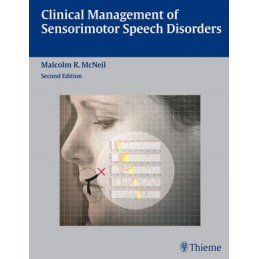- Reduced price

Order to parcel locker

easy pay


 Delivery policy
Delivery policy
Choose Paczkomat Inpost, Orlen Paczka, DHL, DPD or Poczta Polska. Click for more details
 Security policy
Security policy
Pay with a quick bank transfer, payment card or cash on delivery. Click for more details
 Return policy
Return policy
If you are a consumer, you can return the goods within 14 days. Click for more details
The definitive reference for managing sensorimotor speech disorders
Bringing together the expertise of leading research practitioners in the field, the second edition of Clinical Management of Sensorimotor Speech Disorders is an up-to-date reference for the underlying theory and the basic principles of assessment and treatment. This book provides a solid foundation in the conceptual framework essential for classifying and differentiating disorders according to clinical categories. It covers the theory underlying measurement strategies including acoustic, kinematic, aerodynamic, and electromyographic techniques, and guides the reader through treatments for each disorder.
New in this edition is a comprehensive section with in-depth coverage of the diseases, syndromes, and pathologic conditions which are accompanied by sensorimotor speech disorders. These chapters provide concise descriptions of the disease and its signs and symptoms, neuropathology, epidemiology, and etiology. Each chapter goes on to present the speech impairment associated with the disorder and its signs and symptoms, etiology, neuropathology, associated cognitive, linguistic, and communicative signs and symptoms, special diagnostic considerations, treatment, and key references.
Features::
Authoritative and comprehensive, this expanded edition will prove to be the reference of choice for students in speech-language pathology programs as well as clinicians and researchers.
Data sheet
Part I. Primary Topics
1. A Theoretical Framework for the Characterization of Pathological Speech Sensorimotor Control
2. Perceptual Sensorimotor Speech Examination for Motor Speech Disorders
3. Nonspeech Assessment of the Speech Production Mechanism
4. Acoustic Analysis of Motor Speech Disorders
5. Aerodynamic Assessment of Motor Speech Disorders
6. Kinematic Measurement of Speech and Early Orofacial Movements
7. Electromyographic Techniques for the Assessment of Motor Speech Disorders
8. Flaccid Dysarthria
9. Ataxic Dysarthria
10. Hyperkinetic Dysarthria
11. Hypokinetic Dysarthria
12. Spastic Dysarthria
13. Speech Impairment Secondary to Hearing Loss
14. Adult-Onset Neurogenic Stuttering
15. Apraxia of Speech
16. Principles of Treatment for Sensorimotor Speech Disorders
Part II. Pathology
17. Alport Syndrome
18. Amyotrophic Lateral Sclerosis
19. Angelman Syndrome
20. Apraxia of Speech in Childhood
21. Athetoid Cerebral Palsy
22. Cerebellar Mutism
23. Corticobasal Degeneration
24. Creutzfeldt-Jakob Disease
25. Deletion Syndrome
26. Duchenne Muscular Dystrophy
27. Ehlers-Danlos Syndrome
28. Encephalitis
29. Fragile X Syndrome
30. Goldenhar Syndrome and Hemifacial Microsomia: The Oculo-Auriculo-Vertebral Spectrum
31. Guillain-Barre Syndrome
32. Hashimotos Encephalopathy
33. Huntingtons Disease
34. Kennedy Disease/Syndrome
35. Klippel-Feil Syndrome
36. Landau-Kleffner Syndrome
37. Möbius Syndrome
38. Moyamoya
39. Multiple Sclerosis
40. Multiple System Atrophy and Shy-Drager Syndrome
41. Myasthenia Gravis
42. Neurofibromatosis Type 1
43. Neurofibromatosis Type 2
44. Opercular Syndrome (Foix-Chavany-Marie Syndrome)
45. Oromandibular Dystonia
46. Pallidotomy and Deep Brain Stimulation in Parkinsons Disease
47. Parkinsons Disease
48. Picks Disease
49. Postpolio Syndrome
50. Primary Lateral Sclerosis
51. Progressive Apaxia of Speech
52. Progressive Bulbar Palsy (PBP)
53. Progressive Multifocal Leukoencephalopathy
54. Progressive Supranuclear Palsy
55. Rett Syndrome
56. Spastic Cerebral Palsy
57. Systemic Lupus Erythematosus
58. Tardive Dyskinesia
59. Traumatic Brain Injury
60. Vascular Dementia
61. Wilsons Disease
62. Worster-Drought Syndrome
Reference: 81939
Author: Diane M. Scott
